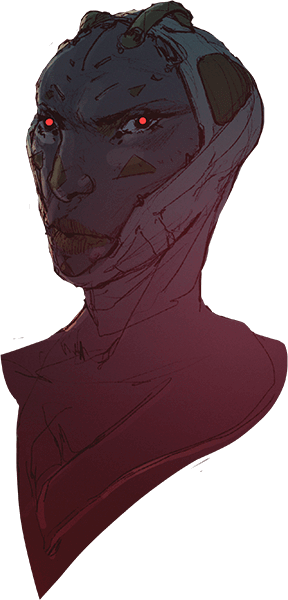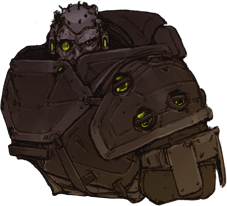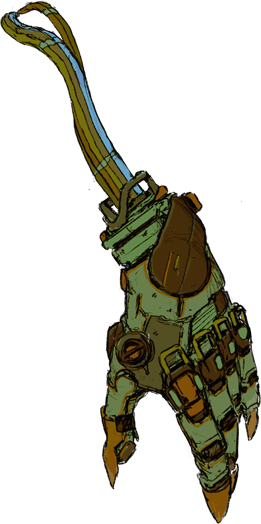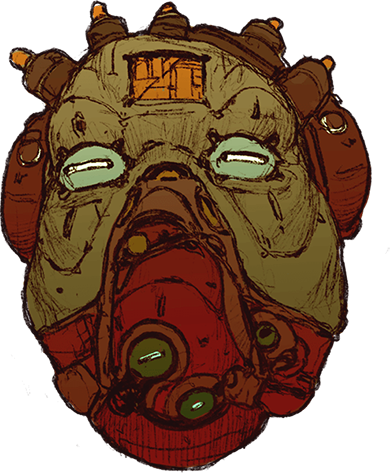Combat

Surprise
If an enemy can escape notice and attack your Operator, you must make a . If the Operator fails this save, they are Surprised by the enemy and cannot act for one (1) . Operators may also surprise their enemies. An Operator gains on their initial attack against any enemy that has not noticed them.
Initiative
To determine initiative order:
- Check for Surprise if necessary.
- Each Squad member then makes a Speed Check:
- Success means the Operator acts before the enemy.
- Failure means the Operator acts after the enemy.
- grants the Operator an extra Major Action immediately.
- limits the Operator to one (1) Major Action on their first turn.
- Installed CyberTech may affect Initiative in different ways.
Turns
Combat is separated into rounds. Within each round, there are turns. A turn is when a single player or enemy takes action(s). The Initiative order determines combatant turns:
- Operators who succeeded on their Speed Check take their turns before the enemies in the order of their Speed Stats from highest to lowest.
- The enemies act in whichever order Control sees fit.
- Operators who failed their Speed Check take their turns after the enemies, again in the order of their Speed Stats from highest to lowest.
A round ends once everyone involved has taken their turn. If the combat isn't completed, a new round begins. A round is approximately 10 seconds of real-time, but Operators act within the turn order determined by their Initiative roll (Speed Check) and Speed Stat. If an Operator or enemy is killed or incapacitated before their turn, they do not get to act.
Actions
On any character's turn, they may (generally) take two (2) Major Actions.
Examples of Major Actions a character can take:
- Attack with a melee weapon
- Reload a weapon
- Fire a weapon
- Throw a grenade
- Move up to half their Speed Stat in meters
- Attempt to someone
- Attempt to break a Grapple
- Activate a piece of gear or CyberTech
- Use a machine
- Apply a medpack
- Use any number of the same item on yourself or others (stim packs, etc.)
In addition, a character may take any number of Free Actions.
Examples of Free Actions:
- Shouting a command
- Looking around
- Taking cover (if used with a movement action)
Control has the final decision on whether an action is considered Major or Free depending on the situation.

Attacks
To attack an enemy in CHROME, regardless of the weapon used, the Operator simply rolls Combat Check.
Ranged and Melee Attacks
- The Operator makes a Combat Check
- On a Success:
- The enemy takes the weapon’s damage (Minus their )
- On a :
- The enemy takes double the weapon’s damage (Minus their Soak)
- On a Failure:
- The attack misses, and the enemy takes no damage
- On a Critical Failure:
- The enemy takes no damage, and the Operator suffers some type of complication. Examples: the weapon jams, the attack hits another Operator.
When an Operator is attacked by an enemy, that Operator can make a to avoid the damage. For most attacks with firearms or melee weapons, this will be a . Alternatively, if the attacker is at Close range, the Operator may choose to take the damage and make a Combat Check to counter-attack the enemy. Some enemies will have attacks that require different Saves by the Operator to resist or avoid.

Defending Against an Attack
Short and Long Range Attacks - the Operator rolls a Reflex Save.
- If you succeed, your character takes no damage.
Close Range Attack - the Operator may choose to roll either:
- Reflex Save (to defend against the damage)
- If you succeed, your character takes no damage.
- Combat Check (to counter-attack)
- Your character takes the damage from the attack and strikes back by rolling a Combat Check.
Grappling or Wrestling
A character may decide to grapple an enemy to hinder them in combat. These hindrances could mean the grappled character loses actions, drops a weapon, becomes distracted, etc. The character grappling an opponent may also have limitations on their movement and types of actions they may take without releasing the grapple. Control will decide whether certain enemies can be grappled and the implications of each grapple based on the situation and characters involved.
- Attempting to Grapple an opponent in combat is a
- Breaking out of a grapple in combat is a Major Action
- Both require a successful Strength Check
Cover and Movement
Cover: If a character shelters behind an object that conceals at least half their body, they receive a bonus of +1 against damage from ranged attacks.
Movement: In combat, a character may move half their Speed Stat (in meters) with a single action or move their full Speed Stat with both actions. Certain types of Armor and CyberTech may affect the character’s movement speed.
For example, some heavy armor types will require players to succeed on a Strength Check to move their total allowed distance. Failure decreases their movement rate by half.
Damage
Health Tracker
Operators begin the game with 10 slots on their Health Tracker. Whenever your Operator takes damage, it is subtracted from their Health.
Damage Tiers
Weapons, effects, and abilities deal one of three tiers of damage:
- Standard (2 Damage)
- Massive (4 Damage)
- Deadly (6 Damage)

Soak
Armor and some CyberTech reduce the amount of damage a character receives from an attack. This damage reduction is called Soak. Whenever a character receives damage, they subtract their Soak value from that damage first, then remove the remaining damage from their .
Example
While trying to infiltrate a Corp facility, Flux has just taken an assault rifle blast at Short from a security guard. The damage from an assault rifle at that range is Deadly (6) damage. Flux has a Soak of 2 from their various armor, so they only receive 4 damage from the attack. (6 - 2 = 4)
Damage and Panic
If the attack against an Operator was a or Deadly (6) damage, the Operator must also roll a .

Severed Limbs
Certain weapons can detach limbs (or the head) from an character’s body. This can make for a tremendously bad day.
When an Operator hits (or is hit) with a successful Sever attack, the player rolls a d10 on the Hit Location Table.
- If the result is 1 thru 4, the character loses the corresponding limb.
- Additionally, the character will take every until a successful Intellect () Check is rolled and first aid is applied.
- A severed limb can be reattached surgically during Downtime. Don’t lose your limbs!
- If the result is 5 thru 9, no additional effect.
- If the result is a 10, the character is decapitated and immediately dies (unless it has multiple heads or is wearing gear that prevents decapitation).
Hit Location
If it becomes necessary to determine the location of a specific wound, the player rolls a d10 and takes the following result:
| 10 | Head |
9-5 | Torso |
04 | Left Arm |
03 | Right Arm |
02 | Left Leg |
01 | Right Leg |
In some situations, Control may decide that a location-based wound is so severe it requires cybernetic replacement or replacement of current CyberTech.

Death and Dying
If an Operator’s Health Tracker is reduced to zero (0), they must immediately make a .
- Failure means the character has died, although certain equipment may allow them to be revived within a short time.
- Success means the character heals 1 point on their and slips into unconsciousness for 1d10 minutes. Upon awakening, the player must roll a .
- When an Operator dies they will manifest their . If the operator is killed during combat, their Death Presence will manifest at the end of their next turn.